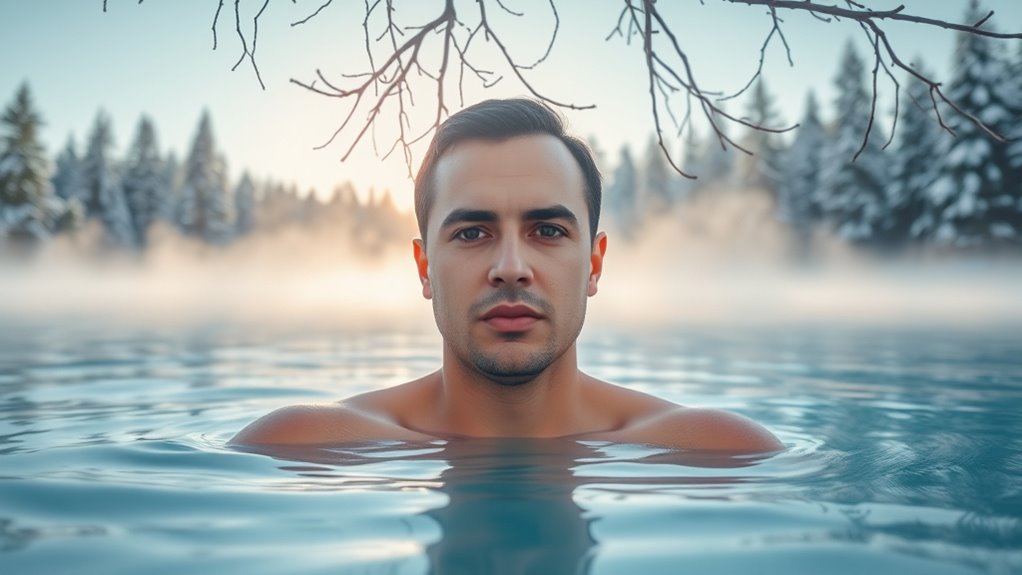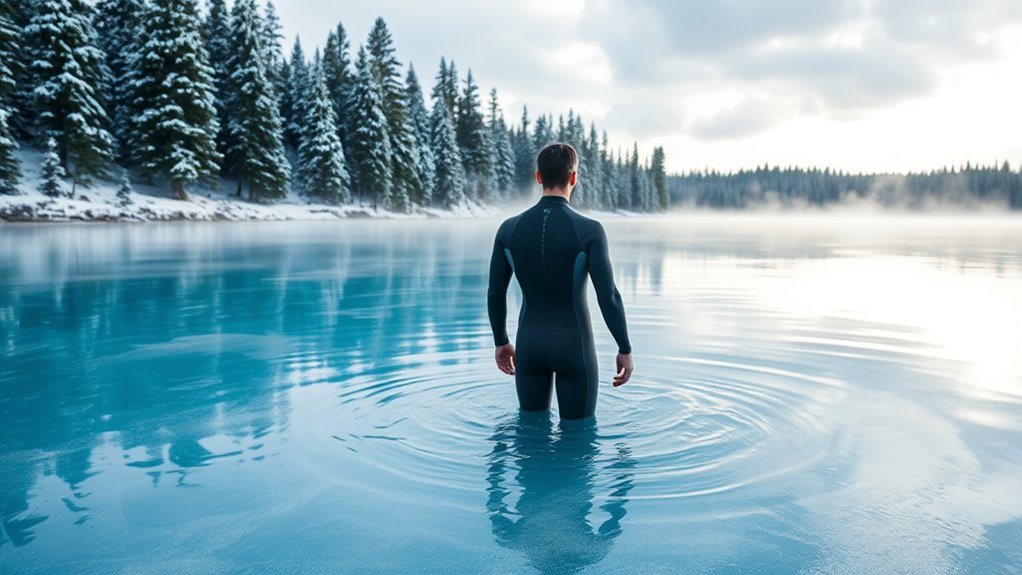Cold-water therapy can boost your physical health by reducing muscle soreness, inflammation, and improving circulation. It also supports mental resilience by enhancing mood, lowering stress hormones, and promoting better sleep. However, risks like hypothermia and blood pressure changes exist, so safety measures are essential. To get started, try gradual exposure with brief dips and proper rewarming. Staying safe while experiencing these benefits is possible—explore how to begin and optimize your practice.
Key Takeaways
- Cold-water therapy offers physical, mental, and sleep benefits by reducing inflammation, boosting mood, and improving sleep quality.
- Risks include hypothermia, frostbite, and cardiovascular stress; safety measures like gradual immersion and supervision are essential.
- Start with brief cold showers or partial immersions, gradually decreasing water temperature and increasing exposure time over weeks.
- Maintain water temperatures around 50°F–59°F, use thermometers, and rewarm gradually to ensure safe adaptation.
- Consistent practice and awareness of body responses maximize benefits while minimizing risks during cold-water therapy.
Unlocking Physical Health Advantages

Cold-water therapy offers several physical health benefits that can enhance your recovery and overall performance. It helps reduce exercise-induced muscle damage, leading to less soreness and inflammation. This means you can bounce back faster and perform better the next day. Cold exposure also decreases inflammation, easing pain and swelling, which is especially helpful for conditions like inflammatory arthritis. Additionally, cold water constricts blood vessels, improving circulation, and when vessels dilate again, it boosts overall blood flow. Cold showers and ice baths may even stimulate your metabolism by causing shivering, which burns fat and turns food into energy more efficiently. Moreover, cold-water immersion can induce vasoconstriction, helping to reduce swelling and improve recovery times. Understanding the underlying mechanisms, such as the body’s response to hypothermia, can help you optimize your cold-water therapy routine. These benefits combine to support faster muscle recovery, reduce discomfort, and enhance your physical resilience, helping you stay active and healthy longer. Incorporating controlled cold exposure can also activate brown fat, which plays a role in thermogenesis and energy expenditure, further supporting your metabolic health. Regular exposure to cold water may also stimulate endocrine responses, promoting hormonal balance that benefits overall well-being. Engaging in regular cold-water therapy may also influence Porsche Tuning principles by optimizing performance characteristics, reflecting how targeted adjustments can improve efficiency and output.
Boosting Mental Well-Being and Stress Resilience

Building on the physical benefits, cold-water therapy also offers powerful mental health advantages. It boosts your mood by increasing dopamine and endorphins, making you feel happier and more alert. Regular immersion helps build stress resilience by lowering cortisol levels and activating the vagus nerve, which reduces tension and anxiety. Emerging research suggests cold exposure may slow neurodegenerative disease progression and improve overall brain function. These mental health benefits can persist even after stopping therapy, supporting long-term resilience. Understanding the benefits of meditation techniques can be used to create calming auditory environments that complement the mental health benefits of cold-water therapy. Additionally, incorporating dog names can foster emotional connection and provide comfort during recovery or stress management routines. Incorporating psychological resilience strategies alongside cold-water therapy can further enhance mental toughness and emotional stability. Recognizing the importance of brain plasticity can help individuals optimize their mental health efforts through consistent practice.
Enhancing Sleep and Overall Life Quality

Immersing in cold water can profoundly improve your sleep quality and overall well-being by calming your nervous system and promoting restorative rest. Cold exposure reduces arousals and limb movements during sleep, especially enhancing deep sleep early in the night. It also signals your body to lower core temperature, easing sleep onset. Additionally, cold water triggers the release of melatonin, the hormone that regulates sleep-wake cycles, leading to longer, more restful sleep. It also lowers cortisol levels, decreasing stress and anxiety, which helps you fall asleep faster and experience fewer nighttime awakenings. Cold therapy reduces muscle soreness and inflammation, supporting physical recovery and preventing discomfort that disrupts sleep. Furthermore, understanding natural sleep regulation can further enhance these benefits by aligning your routines with your body’s biological rhythms. Proper hydration and electrolyte balance are also important, as cold water can influence these factors and improve overall health. Engaging in mindful practices alongside cold therapy may further amplify its calming effects. Incorporating consistent routines and circadian rhythm alignment can optimize sleep quality over time. Together, these effects foster a more refreshed, balanced, and high-quality life.
Navigating Safety and Potential Risks

Managing the safety and potential risks of cold-water therapy requires careful attention, as sudden immersion can trigger involuntary gasp reflexes and rapid changes in heart rate and blood pressure. These reactions increase the risk of drowning, heart arrhythmias, or fainting, especially for those with existing health issues. Prolonged exposure can cause hypothermia, frostbite, or nerve damage, impairing your ability to exit safely. To reduce risks, follow these safety strategies:
- Enter water gradually to allow your body to acclimate
- Avoid breath-holding or hyperventilation during immersion
- Always have supervision, particularly for beginners or children
- Limit immersion time and exit at signs of discomfort
- Rewarm gradually after exiting to prevent temperature shock
- Incorporating AI-enhanced safety features in some devices can help monitor vital signs and alert users to potential health issues
Understanding cold-water physiology can also help you recognize how your body responds during cold exposure. Being aware of these risks helps you enjoy cold-water therapy safely. Proper safety practices are essential for minimizing potential adverse effects. For example, awareness of support hours and availability from assistance services can be crucial if unexpected issues arise during your therapy sessions.
Practical Steps to Incorporate Cold-Water Therapy

To effectively incorporate cold-water therapy into your routine, start by gradually acclimating your body to colder temperatures. Begin with cold showers, lowering the water temperature gradually to a tolerable level, and keep initial exposure brief—around 30 seconds to a minute. Slowly increase duration over time, but limit sessions to no more than 15 minutes to prevent adverse effects. Start with partial immersions like your hands, feet, or chest before progressing to full-body immersion, helping your body adapt with less shock. Use a thermometer to monitor water temperature, aiming for 50°F to 59°F (10°C to 15°C). Ensure your environment is safe and comfortable, and have warm clothes ready for post-immersion. Consistent practice over days to weeks builds comfort and benefits. Understanding the financial impact of wellness practices like cold-water therapy can motivate sustained commitment and long-term health benefits.
Frequently Asked Questions
Can Cold-Water Therapy Help With Chronic Illnesses Beyond Cardiovascular Health?
You might wonder if cold-water therapy can help with chronic illnesses beyond heart health. It can, by reducing inflammation linked to autoimmune diseases, improving mood and cognitive function, boosting metabolism, and strengthening your immune system. Regular cold exposure promotes better circulation and vascular health, supports stress response regulation, and may even slow disease progression. Incorporating cold water therapy could be a beneficial addition to your overall management plan for chronic health issues.
How Does Cold Exposure Affect Mental Health in Individuals With Depression?
When you expose yourself to cold water, it triggers neurotransmitter releases like dopamine, serotonin, and endorphins, which can lift your mood and reduce anxiety. This process may help improve emotional regulation and stress resilience, especially in individuals with depression. However, you should be cautious, as cold exposure carries risks. Always start gradually, monitor your body’s response, and consult a healthcare professional to make certain it’s safe for you.
Are There Specific Populations Who Should Avoid Cold-Water Therapy Entirely?
Think of cold-water therapy as a delicate dance—you need to move carefully to stay in sync. If you’re in certain populations, this dance can become risky. You should avoid cold water immersion if you have uncontrolled high blood pressure, heart rhythm issues, neurological disorders like MS, or are pregnant. Elderly, children, and those with circulatory problems also need to steer clear, as cold stress can overwhelm their bodies.
What Are the Long-Term Psychological Effects of Regular Cold-Water Immersion?
You’ll likely notice long-term psychological benefits from regular cold-water immersion, such as improved mood, emotional regulation, and stress resilience. It helps decrease anxiety and distress while boosting positive feelings like alertness and inspiration. Over time, it can enhance sleep quality and overall mental well-being. Consistent practice fosters neurochemical changes that support emotional stability, making you more resilient to stress and better equipped to handle daily challenges.
Can Cold-Water Therapy Replace Traditional Treatments for Mental Health Conditions?
You might wonder if cold-water therapy can replace traditional mental health treatments. While CWI shows promise for mood improvement and stress resilience, it shouldn’t replace professional care. Instead, consider it a complementary approach. Always consult your healthcare provider before making changes. Relying solely on CWI may overlook underlying issues that require evidence-based therapies, so combining treatments with medical guidance offers the safest, most effective path to mental well-being.
Conclusion
Beginning on cold-water therapy can transform your health and resilience like nothing else. With its incredible benefits, from boosting your mood to enhancing sleep, it’s a game-changer. Just remember to start slow and stay safe—this isn’t a sprint, but a journey worth taking. Plunge in with confidence, and you’ll discover a world where your body and mind become unstoppable. Get ready to unlock a power so profound, it’s almost like having superpowers!









